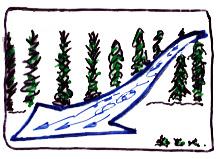
Wind and Turbulence in Forest Cutblocks
Foresty Canada & partners initiated experiments near Manning, Alberta to evaluate alternative harvest practises which aim to preserve the Spruce understory (for later harvest) at the time of hardwood (aspen) harvest. A concern is windthrow of the (previously sheltered) remnant spruce, and so the focus of the Forestry Canada trials is to determine a practicable harvest strategy that leaves uncut "shelter strips" to protect remnant spruce in the harvested areas. (A sketch).
In conjunction with this experiment, and in the hope of providing a theoretical basis on which to interpret the observed pattern of tree blowdown, we (Dr Tom Flesch, myself) placed towers traversing protected cutblocks; we studied two cases
- Cutblocks and intervening forest blocks each of width X=6hc, where hc=23m is the mean tree height
- Cutblocks and intervening forest blocks each of width X=2hc
During periods of extreme wind when mean wind direction (x) was oriented perpendicular to the forest/clearing boundaries, propellor anemometers recorded time series of windspeed, while other sensors recorded the wind-induced angular displacement of several remnant spruce. Our objective: to combine a suitable windflow model with a simple theory of tree motion, in such a way as to provide forest managers with a means to interpret the observed pattern of tree windthrow, and to anticipate what might occur in other cutblock designs.
PROGRESS IN MODELLING OF THE SPATIAL PATTERN OF WIND & TURBULENCE IN CUTBLOCKS
We have compared the time-average windspeed (over 15 or 30 minute intervals) with a solution of the mean momentum equations, closed at first order (eddy viscosity K=l.sqrt(k), where l(x,z) is an imposed lengthscale, and k is the turbulent kinetic energy, calculated from the TKE equation).
The numerical model matches quite well the observed variation in the mean wind across the clearing, (and incidentally, predicts that had we measured the wind in adjacent clearings of this periodic forest-block/clear block matrix, we would have seen virtually the same pattern). Simulated TKE also agreed reasonably well with the observed variation.
Back to Disturbed Windflows .
Back to John D. Wilson home page.
Back to the Earth & Atmospheric Sciences home page.
Last Modified: 26 Sept., 2008
